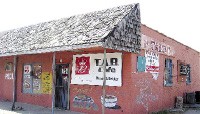While most of the 80,000 attendees at the Bonnaroo Music Festival in Manchester, Tennessee, last weekend were tie-dyed and dreadlocked twenty- and thirtysomethings, the times they are a-changin’, and the festival is changing with them. Rather than the hippie folk music that defined the four previous Bonnaroos, the sold-out crowd last weekend enjoyed a more mainstream headliner: Radiohead.
The 700-acre farm in Manchester that hosts Bonnaroo was like a separate world with its own air of sunscreen, marijuana, and portable toilets. Over four days, more than 130 live acts graced the tents and stages.
Thursday
Traffic was monumental as crowds poured in. Once inside, people spent much of the day setting up their temporary homes and exploring the wide-open spaces. There were no big stage acts — only tent performers — including the Cat Empire, Devotchka, Tortured Soul, and Electric Eel Shock.
Techies hit the free Internet access tent or the “Discotechque Arcade.” Vendors sold everything from bongs to bongo drums. A comedy tent held performances by Lewis Black and Demetri Martin. There was also a movie tent that offered free showings of Walk the Line and The Shining (late at night, of course) and live World Cup coverage.
Friday
The big acts began. Folk-rocker Devendra Banhart played favorites, while Cat Power & the Memphis Rhythm Band made our city proud. Singer-songwriter Andrew Bird did his characteristic act: recording his violin on the spot and re-playing it layered with other sounds. British eclectic band World Party played a varied selection of their repertoire.
The “Which” stage had a fantastic line-up for indie-rock lovers. Crowd-pleaser Ben Folds re-worked a Dr. Dre song (“Bitches Can’t Hang with the Streets”). Bright Eyes’ Conor Oberst brought on guests Jim James of My Morning Jacket and Gruff Rhys of Super Furry Animals. My favorite of the day was the amazing vibe created by Death Cab for Cutie, whose new drummer, Jason McGerr, meshed perfectly.
A powerhouse group of artists united to form Oysterhead: Police drummer Stewart Copeland, Phish frontman Trey Anastasio, and Primus bassist Les Claypool. At night, Stevie Nicks joined Tom Petty & the Heartbreakers to perform their ’80s duet “Stop Draggin’ My Heart Around.” My Morning Jacket played a great folk-rock set, and Lyrics Born, Common, and Blackalicious brought some hip-hop to the farm in a rousing show that lasted from midnight to 3 a.m.
Saturday
Bluesman Buddy Guy and jazz-funk trio Vorzca spiced up the mix, and Blues Traveler performed twice. There was a big day at the “What” stage, which began with Elvis Costello & the Impostors and Allen Toussaint, who performed from their album, The River in Reverse, and made political commentary with a Bush bobble-head. Then came alt-rock staple Beck, whose kinetic energy was accompanied by a puppet show and zany dancers. And finally, the show that blew nearly everyone away: Radiohead. The lighting and sound were perfectly fine-tuned to create a phenomenal interplay between techno-tinged screen projections and the band. Frontman Thom York introduced a couple of songs from the band’s upcoming album, leaving die-hard fans wanting more. The night sky was glittered with fireworks, and glow-sticks were tossed among the crowd. Despite the day’s sweltering heat, I got chills.
Sunday
Bela Fleck & the Flecktones, British rapper the Streets, and moe. played to tired crowds. At night, roots-rock songstress Bonnie Raitt gave a high-quality performance of songs both classic and lesser known, and New York’s post-punk rock legends Sonic Youth gave an exquisite finale to the weekend.
